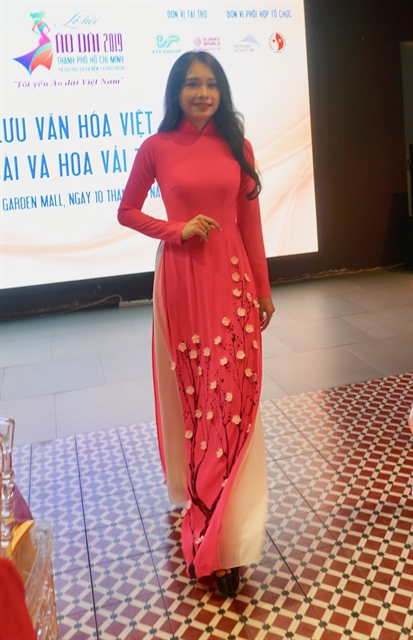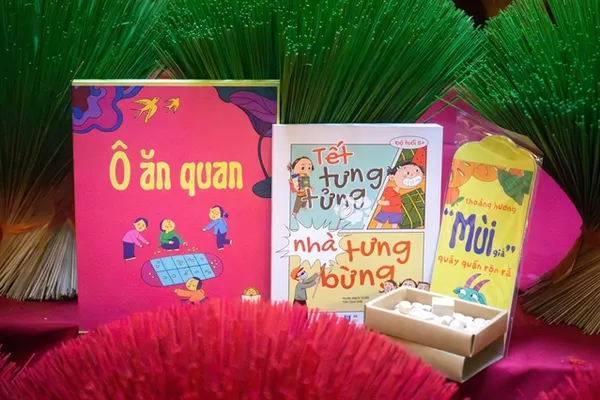 Sunday/Weekend
Sunday/Weekend

The áo dài (Vietnamese traditional long dress) has long been an endless source of inspiration for fashion, poetry, music and movies, and now it is inspiring Vietnamese and Japanese artists to create a new design for the long dress.

|
| Renowned áo dài designer Sĩ Hoàng uses fine silk fabric for his designs in pink decorated with cherry fabric flowers. VNS Photo Thu Hằng |
HCM CITY — The áo dài (Vietnamese traditional long dress) has long been an endless source of inspiration for fashion, poetry, music and movies, and now it is inspiring Vietnamese and Japanese artists to create a new design for the long dress.
The new creative concept is inspired by the traditional Japanese pinching craft called tsumami zaiku.
The tsumami technique is used to make petals, flowers, cranes, and other items for kanzashi (ornamental hairpins) that go with kimonos. It has a long history of about 200 years, according to Japanese artists from TSUMAMIDO, a shop and school in Tokyo dedicated to promoting tsumami zaiku.
Traditional tsumami is made from small squares of silk called habutae. By pinching and holding habutae like an origami with tweezers, each figure is created.
Inspired by the elegant and vividly colourful folded fabric flowers, renowned áo dài designer Sĩ Hoàng used fine silk fabric for his designs in yellow and pink decorated with apricot and peach fabric flowers.
The apricot and cherry blossoms are assembled on the áo dài’s front flaps with painted tree branches.
Hoàng said that apricot and cherry flowers symbolise the spring season and the close friendship of Việt Nam and Japan.
He used a tiny pin to fasten the flowers on the long flaps so the flowers can be easily changed.
Hoàng said that áo dài made of fine silk enhances the beauty of the silk fabric flowers, moving delicately with the woman’s body.
The design is a combination of painting on fabric, in which he is a master, and the Japanaese pinching craft, according to Hoàng.
“I admire the tsumami technique, which makes meticulously folded petals of fabric into beautiful flowers. I was surprised to see the harmonious blend of fabric flowers and the long dress.”
“I hope that the áo dài is not only our national costume but also fashionable attire favoured by women in the world,” he said.
Designer Tùng Vũ has another creative design that combines ribbon embroidery on áo dài with colourful fabric flowers.
“I use Vietnamese traditional ribbon embroidery to add cheerful colour which highlights the spirit of the spring season,” Tùng said.
The handcrafted Japanese pieces of art appear in harmony with traditional Vietnamese ribbon embroidery, creating a new look for Vietnamese áo dài, he said.
The designs were showcased at the two-week Áo Dài Festival that was held in early March in HCM City.
Preservation efforts
Shojiro Kamoshita, an official from the Tsumami Crafted Association, said: “It’s a fantastic idea to combine the Japanese tsumami craft with the Vietnamese traditional dress. It would be incredible if the new concept is widely adopted to áo dài designs as it contributes to preserving the traditional values of the two nations. I hope this brings happiness and new experiences to people around the world who learn how to make tsumami.”
Last year, Masayuki Takahashi, owner of TSUMAMIDO, led a group of Japanese artists to introduce the tsumami craft at a cultural exchange event held during the Áo Dài Festival 2018.
Designs of Vietnamese traditional dress decorated with tsumami flowers by Sĩ Hoàng were displayed for the first time at the event.
Takahashi, who passed away in January, had hoped to attend this year’s festival to promote the traditional Japanese craft in Việt Nam.
Lý Thanh Phương, who is the first Vietnamese tsumami instructor from TSUMAMIDO, said the colourful flowers would enhance the beauty of áo dài. “For me, it is a perfect combination which creates a new look for the long dress which makes the flowers more vivid and lively.”
The flowers in different colours and shapes can be assembled on the sleeves, neck or chest depending on the wish of the wearers.
Huỳnh Ngọc Vân, deputy director of the Việt Nam-Japan Friendship Association in HCM City, said that last year marked the 45th anniversary of bilateral diplomatic ties between the two countries.
The áo dài decorated with tsumami flowers symbolises the close friendship and cultural exchange between the two countries, said Vân, who is also director of the Áo Dài Museum.
She said that the tsumami craft would be widely used in Việt Nam.
Designer Hoàng said that the traditional áo dài had gone through many transformations since the 17th century. It became the áo dài tân thời (modern traditional long dress) or Le Mur long dress in the early 1930s, the neckless áo dài in the 1950s, the hippie áo dài in the 1960s, and now a long dress decorated with embroidery, paintings and drawings along the front flap.
Designers should continue to combine traditional values and international influences in their designs.
Hoàng said he would create a new collection of áo dài decorated with different kinds of fabric flowers with the cooperation of Japanese artists. — VNS




